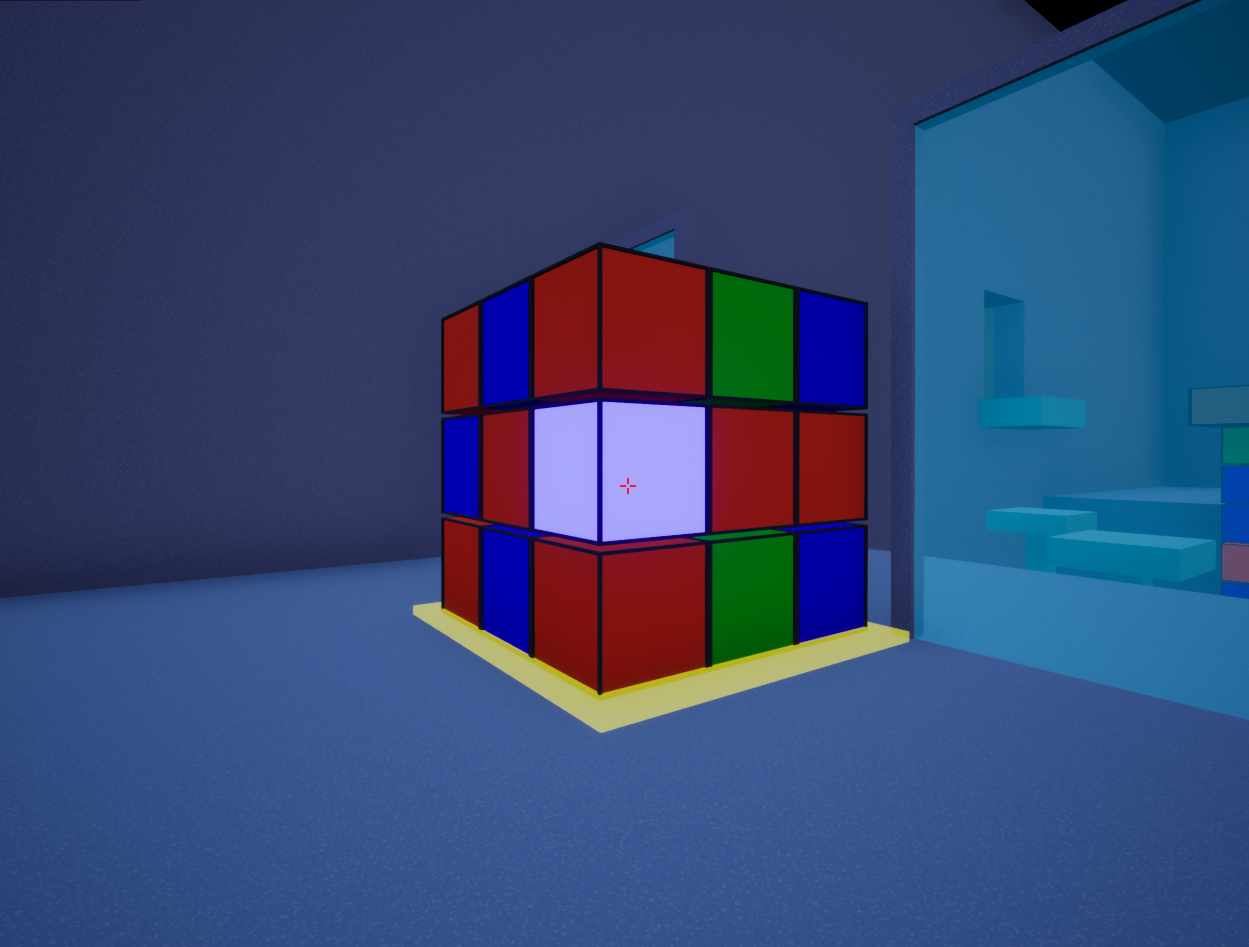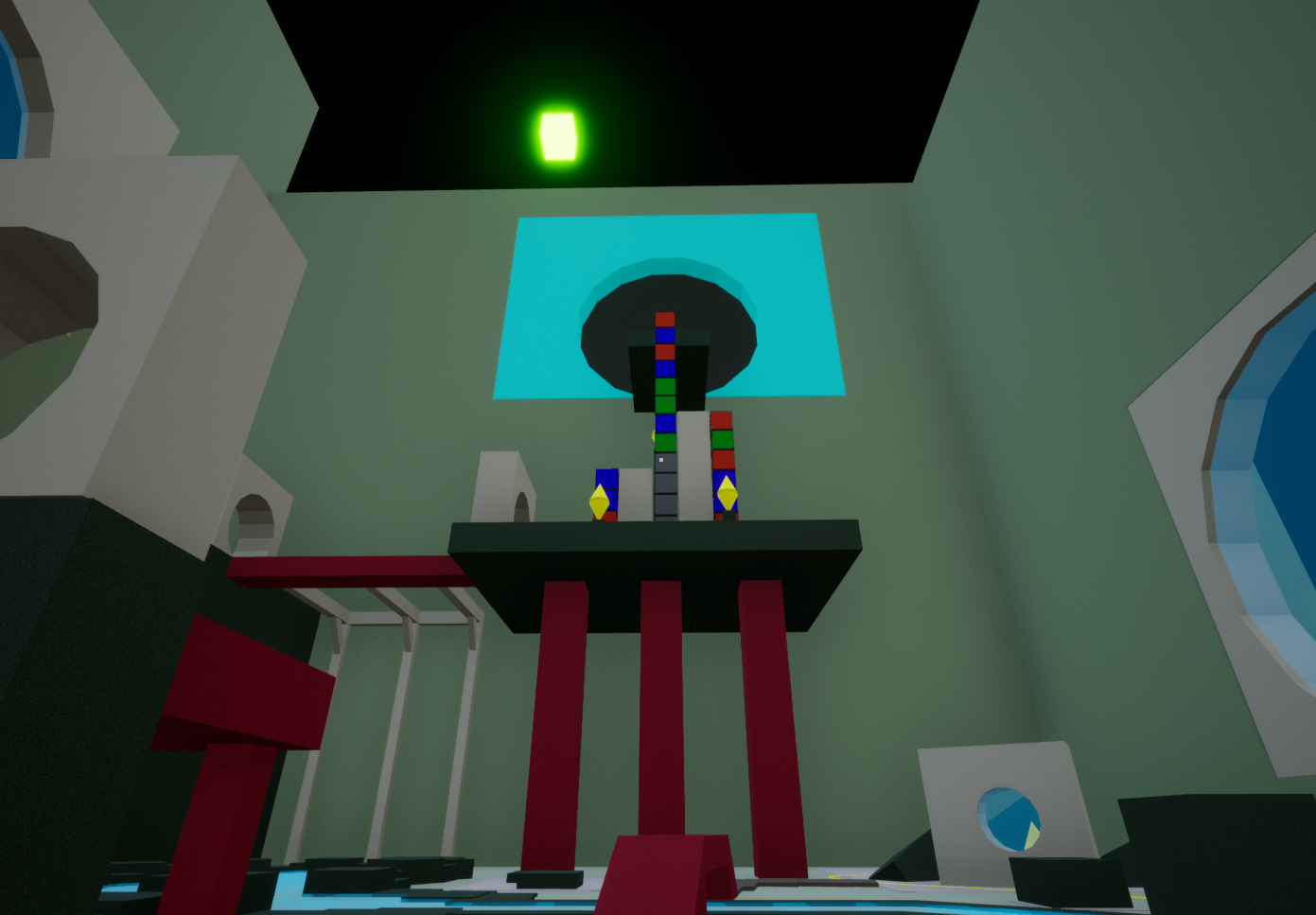Colore
Details - - - - - - - - - - - - - -
Personal project
First person puzzle
2 developers
2020 - 2021
Unreal Engine 4, Git
Contributions
Level design
Game design
System design
Scripter
Description
Colore is a first person puzzle platformer with match-three mechanics. Solve puzzles by using the classic match-three-mechanic, but in three dimensions.
Build stairs and bridges, bring down walls, create elevators and much more. All by using this new take on the match-three-mechanic.
Design pillars
Colore is aimed for people who are not used to playing games. With this in mind enemies, death and lives felt unnecessary and would be too much for the target audience. It would also be distracting from the core experience; i.e., puzzle solving.
We came up with three pillars. No death, slow pace and one mechanic to rule them all. This helped us with keeping the scope tight and guide us to meet the target audience’s needs.
Pillars
No death - Slow pace - One mechanic to rule them all
Target audience
Unexperienced and seasoned players
Game loop
Level design
Level 2 - Zen garden
Level design goals
To teach the player that they can stand on top of a box constellation while using the resetter.
This level should be devoid of any kind of stress so the player can focus on learning.
The previous levels were cramped, small and very straight forward. I wanted my level to be roomy and utilize verticality as a contrast.
I wanted to explore how to use the “rule of three” in this level.
Setting
When designing this level everything fell into place when I decided on the setting; a zen garden. It fit perfectly with my second goal; no stress. A zen garden is all about harmony and balance.
Reflection
The setting was not something I thought of until midway into the creation of Zen garden. In future projects, I will always think about the setting.
Level composition
The level has three floors, three puzzles and objects paired in constellations of three, following the rule of three.
Every floor has one puzzle. Even though the puzzles are in the same room they are separated by the floors. This is good because of two things:
The player will have a sense of progression when completing a puzzle.
The puzzles are self contained, which makes it easier for the player to focus on the puzzle at hand.
Early on, the level evolved toward a spiral flow that I really liked. With three floors the spiral became even more apparent.
Framing - The Moon Door
The moon door became my primary tool for framing important things in this level.
In zen gardens the moon door is a gateway to another world or a state of mind.
Leaving the regular world and only focus on the current is what the moon door symbolizes. I use them for this reason and for framing.
Guiding with color, shapes & lines
Red is a color used in zen gardens usually used for structures like bridges. I used red for structures and as guidance for the player.
I used round shapes to highlight things of importance.
With the environment I create lines that the eyes can follow.
Test - Listen - Iterate
I held many playtest sessions. This helped with ironing out design flaws and killing darlings.
Final puzzle “The three pillars“
I replaced the puzzle in the top image with the puzzle in the bottom image. Playtests showed a few issues with the first puzzle.
It felt cramped and awkward to interact with.
As the final puzzle in the level it felt underwhelming and too easy.
I realized it had some design issues that were harder to fix compared to making a new puzzle.
Iteration
The bottom image shows the final version. As you can see the final version is very different from the origin. There are two reasons for this.
Playtesting and iteration from feedback.
I started to think about the setting.
The setting is what really changed everything. The room became bigger, bridges were added and I created a color palette for the level. The end product started to materialize.
What still remains is the spiral-like flow in the level and the verticality.
Ideation
First prototype
One day at school Joakim hollered me over to his desk. Usually he has something interesting to show and would like me to give feedback on it.
This time it was cubes falling from the sky in a random pattern creating a bigger cube. I told Joakim that it would be cool if the player could destroy the cubes like in Tetris:
Align cubes in the correct order, and they get destroyed. This would later become the fundament of Colore.
Match three in 3D
Among all the ideas that we had, we went with the old and trusty match-three-mechanic, in 3D space as a twist. This felt new and exciting.
Inspiration & research
Portal is the main source of inspiration for both the setting and the gameplay.
When it comes to progression, navigation and general design Portal has it all. We decided to steal what we liked. Like Picasso once said “Good artists copy, great artists steal”.
Instead of the portals, we have the match-three-mechanic.
Mechanics
Synergy
The match-three-mechanic is the core of the game. When designing new features it has to complement or enhance the match-three mechanic.
After a mechanic was implemented, we had a jam session where we tried to come up with fun and interesting interactions and puzzles. If the feature did not add anything, that feature got cut out.
When problems create mechanics
Some of the mechanics sprung from a solution to a problem.
The resetter is a good example; it solved the problem of when the player failed a puzzle.
We realized it could create interesting interactions as well.
Standing on the puzzle while resetting will elevate you on top of the puzzle.
One resetter can be connected to multiple puzzles to add complexity, and many more gameplay beats were born from the resetter.
System design
Puzzle layout tool
Before we made this tool we had to place every component by hand, one by one. We had to streamline this process and therefore we created an unreal editor tool. The puzzle layout tool.
Match-three-system
Scalability was very important when creating this system. We wanted it to be easy to add more colors and box types and to change how many boxes need to be destroyed.
Respawn system
One problem we had is that if the player got squeezed by falling boxes the player got stuck in the constellation.
A solution to this was a respawn system for every box constellation.
If the player’s head touches a falling box, it triggers the respawn event.
Team dynamic
Joakim and I think alike in many ways. We have similar basic values and share the same mindset. This makes it very easy to work together.
However when it comes to level, game and system design, we have had a lot of arguments about how to do certain things.
When it comes to system design, I like to think every step through and visualize it with pen and paper. When I think it is ready, I implement it in the engine. Joakim on the other hand jumps directly into the engine and tries things out.
Joakim is more of an architect when it comes to level design and I’m more like a child playing with lego and play doh. My more playful approach in combination with Joakim’s more elegant ways have spiraled us to new heights.
I think our differences when it comes to design, in combination with solid basic values, has been a key factor in our collaboration and the success of this project.
Openness to change and new ideas, dual coding, working late nights, talking system design over a couple of beers and having a lot of different opinions created this game, and I also made a good friend in the process.
Pay a visit to Joakim’s portfolio joakim-design.com
When bouncing ideas we threw this guy to each other. The one who had the fish was allowed to do the talking, so that we wouldn’t talk over each other.






















